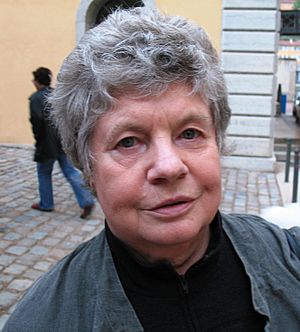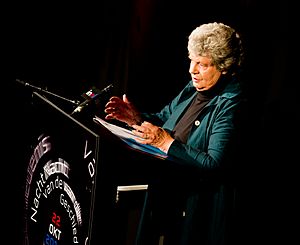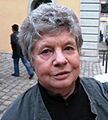A. S. Byatt facts for kids
Quick facts for kids
Dame
A. S. Byatt
|
|
|---|---|

Byatt in Lyon in 2007
|
|
| Born | Antonia Susan Drabble 24 August 1936 Sheffield, West Riding of Yorkshire, England |
| Died | 16 November 2023 (aged 87) London, England |
| Occupation |
|
| Alma mater | |
| Period | 1964–2016 |
| Notable works |
|
| Notable awards | Booker Prize 1990 Aga Khan Prize for Fiction 1995 Shakespeare Prize 2002 James Tait Black Memorial Prize 2010 Erasmus Prize 2016 Park Kyong-ni Prize 2017 Hans Christian Andersen Literature Award 2018 |
| Spouses |
Ian Byatt
(m. 1959; div. 1969)Peter Duffy
(m. 1969) |
| Children | 4 |
| Relatives |
|
Dame Antonia Susan Duffy (born Antonia Susan Drabble; 24 August 1936 – 16 November 2023), known as A. S. Byatt, was a famous English writer. She wrote novels, short stories, and poems. Her books have been translated into more than 30 languages around the world.
After studying at the University of Cambridge, she started writing her first novels. She later took a teaching job in 1972. A sad event happened that year when her son, Charles, passed away at age 11. This deeply affected her. Byatt taught for 11 years, then became a full-time writer in 1983.
Her novel Possession: A Romance won the 1990 Booker Prize. Her short story collection The Djinn in the Nightingale's Eye won the 1995 Aga Khan Prize for Fiction. Her novel The Children's Book was nominated for the Booker Prize in 2009. It won the 2010 James Tait Black Memorial Prize.
Contents
About A. S. Byatt
Early Life and Education
Antonia Susan Drabble was born in Sheffield, England, on 24 August 1936. She was the oldest child in her family. Her father was a judge, and her mother was a scholar. Her sister, Margaret Drabble, also became a well-known novelist.
During Second World War, her family moved to York because of bombings in Sheffield. Byatt went to two boarding schools, Sheffield High School and The Mount School. She later studied at Newnham College, Cambridge, Bryn Mawr College in the United States, and Somerville College, Oxford. She learned French, German, Latin, and English. She also learned Italian so she could read the famous poet Dante.
Byatt taught at the University of London and University College London before she started writing full-time in 1983.
Personal Life and Family
Byatt married Ian Byatt in 1959. They had a daughter and a son named Charles. Their marriage ended in 1969. Later that year, Byatt married Peter Duffy, and they had two more daughters.
Byatt enjoyed watching sports like snooker, tennis, and football. She lived mostly in Putney, London. She passed away at home on 16 November 2023, at the age of 87.
What Influenced Her Writing
A. S. Byatt was influenced by many famous writers. These included Henry James, George Eliot, and Emily Dickinson. She also liked poets like T. S. Eliot and Tennyson. She often mixed real-life stories with fantasy in her books.
She was not a fan of the Brontë family's work. She also knew Jane Austen's books by heart before she was a teenager. Byatt's books often use ideas from Romantic and Victorian literature. She was also interested in zoology, entomology (the study of insects), geology, and Darwinism.
Her Books and Stories
How She Started Writing
Byatt wrote a lot when she was at boarding school. She began her first novel while at the University of Cambridge. She later sent her novel to a literary critic, John Beer, who helped her get it published. Her first editor was Cecil Day-Lewis.
Her first novel, Shadow of a Sun, was published in 1964. It was later reprinted with its original title, The Shadow of the Sun. Her second novel, The Game, came out in 1967.
The Quartet Series
Byatt wrote a series of four novels called The Quartet. These books follow the life of a young intellectual named Frederica Potter. The series includes:
- The Virgin in the Garden (1978)
- Still Life (1985)
- Babel Tower (1996)
- A Whistling Woman (2002)
These books describe Britain in the mid-20th century. They show Frederica's journey from studying at Cambridge to making a new life in London as a single mother. Byatt said she was interested in how women of her generation often felt trapped by home life.
Short Stories and Other Novels
Byatt was also a talented short story writer. Her first collection was Sugar and Other Stories (1987).
- The Matisse Stories (1993) has three stories, each inspired by a painting by Henri Matisse.
- The Djinn in the Nightingale's Eye (1994) is a collection of fairy tales.
- Other collections include Elementals: Stories of Fire and Ice (1998) and Little Black Book of Stories (2003).
Her novel Possession (1990) tells the story of two modern-day researchers. They uncover the secret lives of two fictional 19th-century poets. This book won the 1990 Booker Prize and was made into a film in 2002.
Byatt's novella Morpho Eugenia was part of Angels & Insects (1992). This book was also made into a film in 1995.
The Children's Book (2009) is a novel that takes place from 1895 to the end of the First World War. It focuses on a fictional writer named Olive Wellwood, who was inspired by the real writer E. Nesbit. The book also features real historical figures like H. G. Wells and George Bernard Shaw.
Byatt loved the process of "making things" through writing. She wrote her fiction by hand, often starting her writing day by reading.
Awards and Honours

A. S. Byatt received many awards and honours for her contributions to literature.
- In 1990, she was made a Commander of the Order of the British Empire (CBE).
- In 1999, she was promoted to Dame Commander of the Order of the British Empire (DBE). This is a very high honour for her services to literature.
- She was often mentioned as a possible winner for the Nobel Prize in Literature.
- In 2008, The Times newspaper named her one of the 50 greatest British writers since 1945.
Some of her major awards include:
- 1990: Booker Prize for Fiction, for Possession: A Romance
- 1995: Aga Khan Prize for Fiction, for The Djinn in the Nightingale's Eye
- 2002: Shakespeare Prize (Germany)
- 2010: James Tait Black Memorial Prize, for The Children's Book
- 2016: Erasmus Prize (Netherlands), for "exceptional contribution to literature"
- 2017: Park Kyong-ni Prize (South Korea)
- 2018: Hans Christian Andersen Literature Award (Denmark)
She also received many honorary doctorates from universities like University of Durham, University of Liverpool, and University of Cambridge.
Memberships
Byatt was a member of several important committees and boards related to literature and education:
- 1987–1988: Kingman Committee of Inquiry into the teaching of English Language
- 1984–1988: Management Committee, Society of Authors (serving as Chairman from 1986–1988)
- 1993–1998: Board, British Council
- 2014: American Academy of Arts and Sciences, Foreign Honorary Member
Works
Novels
The following books form a tetralogy known as The Quartet:
- 1978 – The Virgin in the Garden
- 1985 – Still Life
- 1996 – Babel Tower
- 2002 – A Whistling Woman
Other novels:
- 1964 – Shadow of a Sun (reprinted in 1991 as The Shadow of the Sun)
- 1967 – The Game
- 1990 – Possession: A Romance
- 2000 – The Biographer's Tale
- 2009 – The Children's Book
- 2011 – Ragnarok: The End of the Gods
Short Story Collections
- 1987 – Sugar and Other Stories
- 1993 – The Matisse Stories
- 1994 – The Djinn in the Nightingale's Eye
- 1998 – Elementals: Stories of Fire and Ice
- 2003 – Little Black Book of Stories
- 2021 – Medusa's Ankles: Selected Stories
Novellas
- 1992 – Angels and Insects (includes Morpho Eugenia and The Conjugial Angel)
Essays and Biographies
- 1965 – Degrees of Freedom: The Early Novels of Iris Murdoch
- 1970 – Wordsworth and Coleridge in their Time
- 1976 – Iris Murdoch: A Critical Study
- 1989 – Unruly Times: Wordsworth and Coleridge, Poetry and Life
- 1991 – Passions of the Mind: Selected Writings
- 1995 – Imagining Characters: Six Conversations about Women Writers (with Ignes Sodre)
- 2000 – On Histories and Stories: Selected Essays
- 2001 – Portraits in Fiction
- 2016 – Peacock & Vine: On William Morris and Mariano Fortuny
Texts Edited
- 1989 – George Eliot: Selected Essays, Poems and Other Writings (editor with Nicholas Warren)
- 1995 – New Writing Volume 4 (editor with Alan Hollinghurst)
- 1997 – New Writing Volume 6 (editor with Peter Porter)
- 1998 – Oxford Book of English Short Stories (editor)
- 2001 – The Bird Hand Book (with photographs by Victor Schrager)
Images for kids
See also
 In Spanish: A. S. Byatt para niños
In Spanish: A. S. Byatt para niños



